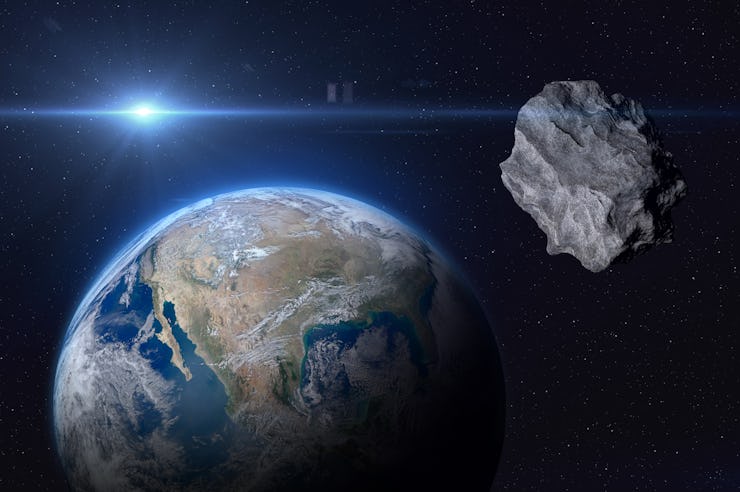Meet the NASA Scientists Who Decide Which Asteroid You Need to Worry About
Two potentially hazardous asteroids have come and gone lately. What gives?

Asteroid 2023 DW made a splash last week, as it zoomed to the top of NASA and European Space Agency danger lists, with a 1-in-560 chance it would come crashing into the Earth in the year 2046. But now 2023 DW is old news, and 2023 DZ2 — which will pass between the Earth and the Moon this Friday — is being worked up for its 1-in-430 chance of impact in 2026.
So what happened? Behind the headlines, astronomers gather data on asteroid trajectories, with NASA turning to a system known as Sentry, operated by the Jet Propulsion Laboratory’s Center for Near-Earth-Object Studies, or CNEOS. Through Sentry, a potentially hazardous rock can be analyzed and whittled down to get cleaner probabilities, letting us know how much we should, or shouldn’t, worry about a space rock threat.
Speaking with Inverse, Davide Farnocchia, Sentry’s navigation engineer, explains that Sentry “takes all the asteroids that have been discovered, and on a daily basis — as soon as the data becomes available — tries to find any possible collision over the next hundred years.” And if there’s a greater than one-in-ten million probability of a collision as the system simulates out the next century of the Solar System, Sentry issues a warning.
Here's why some killer asteroid threats fizzle out before you have a chance to even fully panic.
How to Measure Asteroid Risk
Sentry’s warnings are measured in two scales, both named after the Italian cities where they were first presented: the Palermo Technical Impact Hazard Scale, which measures an impact’s risk compared to the average object of the same size, and the Torino Scale, which combines probability, size, and speed into a single number between zero and 10.
2023 DW, at about 50 meters across, rated a 1, as, briefly, did 2023 DZ2. Ones are relatively common, enough that in 2005, just six years after the system’s introduction, astronomers renamed the category from “Events Meriting Careful Monitoring” to “Normal.” The object to have achieved the highest rating on the Torino Scale is 99942 Apophis, which held a rating of 4 — “Meriting Attention by Astronomers,” at the time called “Events Meriting Concern” — for all of four days.
The fairly fast declines in concern are part of the system, Farnocchia says, are part of its design. “We provide information to astronomers all over the world,” he says. When Sentry tags an object, “we have surveys, optical telescopes mostly, from the ground … They just scan the sky, and when they see something moving compared to background stars, they report the data to the Minor Planets Center.” The Minor Planets Center in Massachusetts acts as a clearinghouse for data about asteroids, and it’s where Sentry draws its data from. “So usually in the morning we have an updated assessment of what the impact probability will be over the next hundred years, and that’s ready for astronomers to take a look at before they schedule their observing night,” he says.
Surface of the asteroid Eros.
When an asteroid is spotted for the first time, there’s often a brief uncertainty about the shape of its orbit. Confirming not just an orbit but that the asteroid is actually real “usually takes a couple days,” Farnocchia explains, “so once you have data from two or three nights, you have a good grasp of what the orbit looks like in space, and you can plot the ellipse of what the orbit looks like in the Solar System.”
But where the asteroid is when it’s found is less important than where it will be: “There is going to be uncertainty about where the object is along its orbit, and that gets better and better as you extend the arc in time,” he says. Usually, these concerns dissipate in “matters of weeks at the most,” although in some cases — like Apophis — they can take longer. As observing data got more accurate, it allowed astronomers “to rule out an impact in 2029, but opened up impacts in 2036.” It took 17 years for astronomers to finally sound the all-clear in 2021.
How to De-escalate
Part of why jumps up just to 1 on the Torino Scale are common is because astronomers are getting closer to identifying all the actually dangerous rocks with orbits that might overlap Earth’s. Congress has requested NASA catalog every asteroid down to 140 meters across — still almost three times wider than 2023 DW — after analysis has shown that over 90 percent of the estimated 1000 near-Earth asteroids over one kilometer wide have been charted. Those are ones that are big enough to have global consequences and subsequently hop up the scale.
Now, NASA has been tasked with finding as many near-Earth objects as they can down to 140 meters, the size that would cause regional devastation. “We’re at 40 percent right now,” Farnocchia says. “We need to improve in the next few years to reach the completeness we’re asked to get to.” Two very different new projects will help with that: the Vera Rubin Observatory and the NEO Surveyor mission. NEO Surveyor, planned for launch in 2028, will be a space telescope at Earth’s L1 point in space, looking for near-Earth objects in infrared, watching as they’re heated by the Sun. The Vera Rubin Observatory in Chile, expected to begin operation next August, will use a massive mirror to photograph the entire sky every few nights.
Still, Farnocchia expects objects will continue to pop up — if only out of extreme caution. “We have about 1000 objects with an impact probability greater than 1 in 10,000,000,” he explains. “We try to be really cautious and go all the way down to 1:10,00,000. Even if it’s as small as two in ten million, we want to catch it.”
This article was originally published on